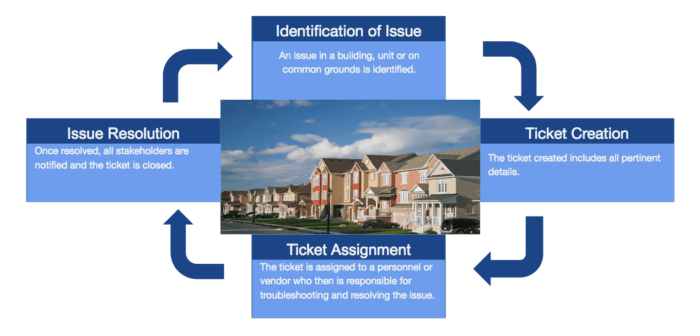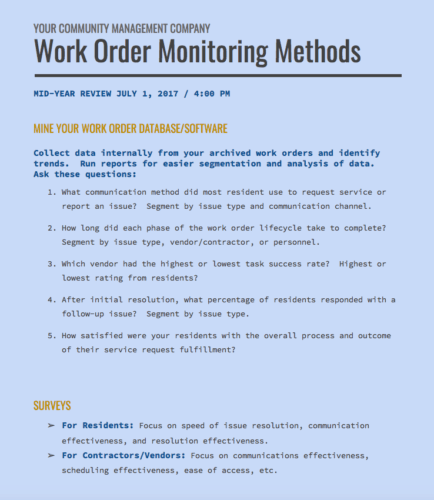5 Best Practices to Enhance Your Work Order Lifecycle
The indoor and outdoor environments of residential communities must be maintained on a regular basis to provide a comfortable living experience for your residents, maintain a safe and clean environment on your premises for everyone, be in compliance with regulations, and enhance brand integrity of your community management. To deliver on those goals, it is essential to keep track of all issues so that nothing falls through, no matter how big or small the issue is.
Any issue tracked goes through a work order lifecycle process:

Work Order Management Lifecycle
Thus, community managers have the challenging task of making lifecycle process more efficient. Here, we emphasize on five best practices you as a manager can implement to make the work order process smoother and completely in line with company objectives.
-
Educate your team and residents on how to identify problems
Make sure that your personnel understands how to identify problems, classify problems by level of urgency, and take the appropriate action. Schedule a training program as part of new staff on-boarding. Additionally, hold regular training sessions for your team, preferably before each season starts. Likewise, residents also need to be informed on how to identify problems before they escalate. To help your residents spot problems that cannot be identified easily, you may opt to write short articles and upload them to a knowledge base your residents can easily access.
-
Maintain an organized system for the entire work order lifecycle
When service requests come in abundance from your residents, it is important to create and maintain an organized system for filing in those requests and seeing them through fulfillment. Ensure that the system you use for filing work orders permits you to input the most essential details and allows you to move with ease from one phase to another. Also, ensure that your work order management software provides reports for both stale work orders that fell through the cracks as well as new ones.
-
Assign a company personnel, vendor, or contractor to resolve the issue
When creating a work order ticket, assign a company personnel to track the ticket from identification to resolution. Then, based on the type of service requested or problem identified, select your preferred vendor and schedule them to come in.
-
Keep your residents in the loop
Communicate with your residents on the status of the service request throughout the process. Implement a process for keeping them informed either through a web portal, email, text, or phone call.
-
Monitor efficiency of work order process/resolution and revise workflow strategy
Create a goal to monitor the efficiency of your work order lifecycle process from problem identification to problem resolution every six months or once a year. Use the data and feedback you receive from your monitoring efforts to revise the strategy and update your workflow for better results. Take a look at the guideline below for how you can gain feedback to further analyze the efficiency and effectiveness of your work order lifecycle.












